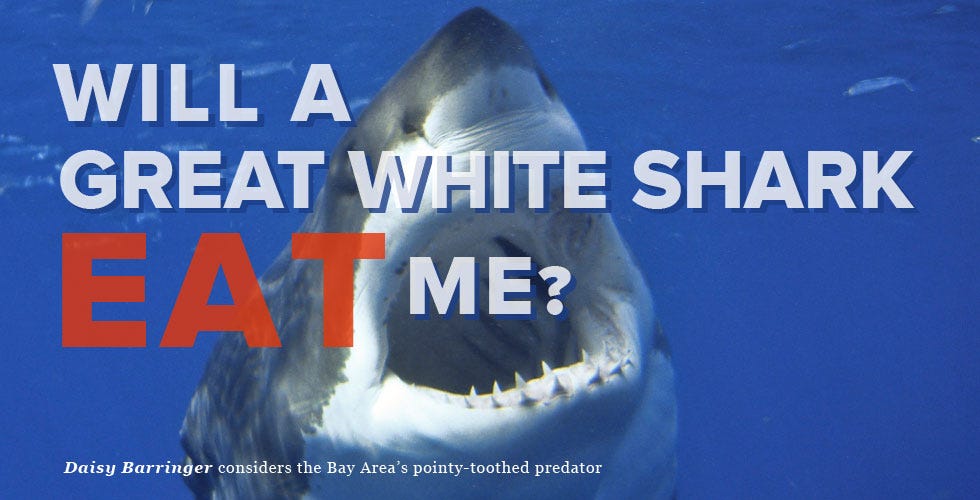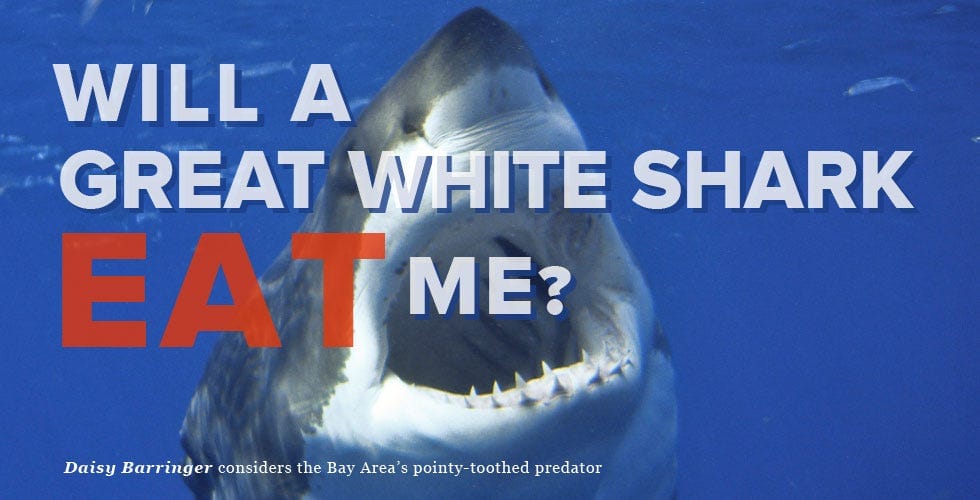
By Daisy Barringer
Before I start, let me be clear: in no way, shape, or form do I call myself a surfer. There was a time, yes, when I paddled out two or three times a week at beaches such as Linda Mar and Bolinas; but even during my most successful sessions, I never caught more than five waves. That being said, I have spent enough time in the ocean — sometimes on evenings that were so foggy, I could barely see ten feet in front of or behind me — that I’ve had plenty of time to think and worry about everyone’s favorite ocean dweller: the great white shark.
Growing up in SF, I knew from a very young age that there were dangerous sharks in the ocean. But since the water was too cold to do more than dip a toe in, I never worried about them. (I did, however, have delusional nightmares about enormous tsunamis swallowing the entire city in one gulp, but that’s another story for another day.) However, once both of my brothers started surfing, the danger of sharks became a real fear. After all, the lure of an awesome wave seemed to far outweigh any thoughts they had about being eaten alive by Jaws — never mind that their little sister was convinced she was soon to be an only child.
But once I started “surfing,” I got it. Sharks were a legit threat, yes, but somehow I convinced myself that they weren’t a real threat to me. “They’ll get a way better surfer before they’ll even come close to me,” I’d say. Or, “Sure, they closed the beach yesterday because of a shark sighting, but he was seen devouring a seal, and everyone knows that after a big meal, a shark can go almost three months before needing another one.” This is exactly how I and many others rationalized getting in the water at the exact spot a shark “attacked” less than 24 hours earlier. My favorite is when Stinson Beach is closed to swimmers because of a shark sighting, but Bolinas — which is about a mile across the channel — stays open. Because great whites totally don’t swim at 15 mph or anything.



The good news is that people don’t often actually die from a great-white-shark attack in Northern California. The last fatality was in 2004 off the shore in Mendocino (Fort Bragg). Randy Fry was diving for abalone when he was attacked by a great white. His headless body was recovered the next day (yikes). The previous fatality also a guy diving for abalone, Omar Conger, who was mortally wounded by a great white off Pigeon Point (between Half Moon Bay and Santa Cruz) in 1984. Before that, there hadn’t been a great-white-related death for 25 years. Eighteen-year-old Albert Kogler Jr. was killed in 1959 by a great white while swimming 15 feet away from the shore at Baker Beach. (Note: great whites seem to be more attracted to men than women. Bad for my brothers. Good for Daisy! And for those of you ladies who are too nervous to swim in the Pacific when you have your period? Don’t worry. While great whites can certainly detect blood — they’re rumored to be able to smell one drop of blood in 25 gallons of water from over a mile away — there’s no evidence that a menstruating woman is setting herself up as easy prey.)
In fact, those are the only fatalities from great-white-shark attacks (since records were authenticated in 1952) in Northern California ever. If you want to die from a great-white-shark bite, your odds are slightly better if you go to central California (Monterey) or further south. Since 1926, of the 13 verified fatalities, three were in Northern California, four in central California, and six in Southern California. It’s a misconception that great whites wholly prefer the cold Northern California water. They’re a migratory species, and who doesn’t like to head south for the winter?
That being said, if you just want to get a sizable chunk bitten out of you, stick around here. Most of US great-white-shark attacks have occurred in the “Red Triangle,” the region that extends from Bodega Bay out to the Farallon Islands and down to Big Sur. You can thank all the savory sea lions, seals, and otters for that. Good eatin’!



The truth is, great whites don’t actually want to eat humans. They usually attack them because they see swimmers or surfers and mistake them for seals. We’re too bony for their sensitive shark tummies. (Fingers crossed that a great white never sees my ass; I am certain he’d change his mind about not liking humans in two seconds.)
However, just because great whites don’t find us delicious doesn’t mean they don’t sample us from time to time. Usually, they take one bite and spit us out, but with 300 serrated teeth in up to seven intimidating rows, it’s unlikely a victim will escape without damage of some kind. (Fun fact: Great whites don’t chew their food. They use their teeth to rip their prey into pieces they can swallow whole. I guess no one ever taught them the joy of savoring a meal.)
Most recently, a 25-year-old man received a 14-inch bite in the rib and hip area while surfing off the coast of Eureka in October of 2012 (he lived), and a kayaker paddling off Pacifica State Beach was attacked by a juvenile shark “with pink gums and teeth barred” in June of 2013. He was lucky, though, as the shark only bit into the kayak, and after grasping it for about ten seconds, the shark got bored and swam away. In 2012, there were more shark attacks in the US (53) than there have been since 2000. (Yay?)

The good news (for the sharks, at least) is that despite several petitions to list the species as endangered, the National Marine Fisheries Service said in June 2013 that after doing a year of extensive research, it was determined that great whites don’t face extinction anytime soon, even though their population has dropped due to hunting, unregulated trade, and dying slowly and painfully in fishing nets.
What does this mean for those of us in Northern California who can’t resist the call of the ocean? Next time you take a swim in the ocean, are paddling around in a kayak, go scuba diving with friends, or take your board out to catch a few waves, remember that the great whites may very well be nearby. But if they attack you, it’s probably a mistake. And who doesn’t make those?







